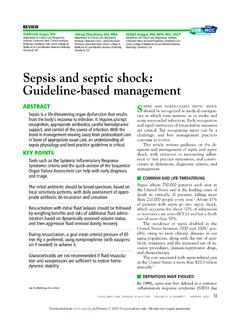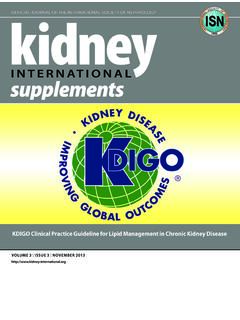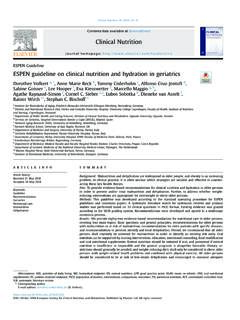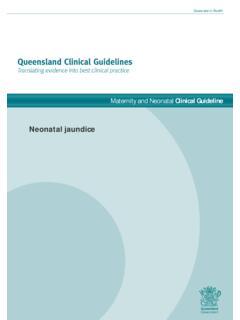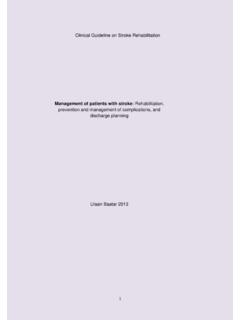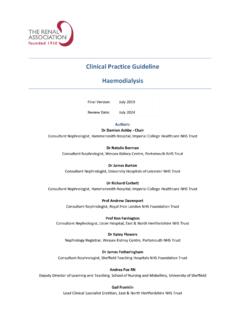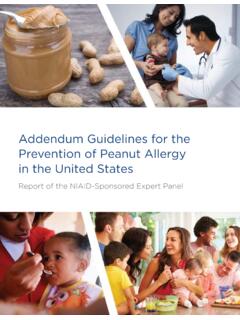Transcription of HIV/AIDS Evidence Based Nutrition Practice Guideline ...
1 HIV/AIDS Evidence - Based Nutrition Practice Guideline , 2010 1 HIV/AIDS Evidence Based Nutrition Practice Guideline Executive Summary of Recommendations Academy of Nutrition and Dietetics Executive Summary Recommendations 19 major recommendations with ratings Recommendations are(see table on last page): o Rated: Strong, Fair, Weak, Consensus, or Insufficient Evidence o Considered: Conditional or Imperative Published in 12/201o by the Academy of Nutrition and Dietetics (AND). What is an Evidence - Based Nutrition Practice Guideline ? A series of guiding statements and treatment algorithms Developed using a systematic process for identifying, analyzing and synthesizing scientific Evidence . Designed to assist practitioner and patient decisions about appropriate Nutrition care for specific disease states or conditions in typical settings. Key elements include: o Scope of the Guideline o Interventions o practices considered o Major recommendations and o Corresponding rating of Evidence strength o Areas of agreement and disagreement Learn more: Access o Limited to Public o Full to Academy members and EAL subscribers Medical Nutrition Therapy, Screening and Referral 1.
2 HIV/AIDS : Medical Nutrition Therapy (MNT) Medical Nutrition therapy (MNT) provided by a registered dietitian (RD) is recommended for individuals with HIV infection. Four studies regarding MNT (with or without oral nutritional supplementation) report improved outcomes related to energy intake, symptoms and cardiovascular risk indices. Two studies regarding nutritional counseling (non-MNT) also report improved outcomes related to weight gain, CD4 count and quality of life. Strong Imperative 2. HIV/AIDS : Frequency of Medical Nutrition Therapy (MNT) The Registered Dietitian (RD) should provide at least one to two Medical Nutrition Therapy (MNT) encounters per year for people with HIV infection (asymptomatic) and at least two to six (or more) MNT encounters per year for people with HIV infection (symptomatic but stable, acute or palliative), Based on the following: HIV/AIDS Evidence - Based Nutrition Practice Guideline , 2010 2 Appropriate disease classifications Nutritional status Comorbidities Opportunistic infections Physical changes Weight or growth concerns Oral or gastrointestinal symptoms Metabolic complications Barriers to Nutrition Living environment Functional status Behavioral concerns or unusual eating behaviors.
3 Studies regarding MNT (with or without oral nutritional supplementation) report improved outcomes related to energy intake, symptoms, and cardiovascular risk indices, especially with increased frequency of visits. Consensus Imperative 3. HIV/AIDS : Screening for People with HIV Infection The registered dietitian (RD) should collaborate with other health care professionals, administrators and public policy decision-makers to ensure that all people with HIV infection are screened for Nutrition -related problems, Based on referral criteria regardless of setting, at every visit. People with HIV infection are at nutritional risk at any time-point during the course of their illness. Consensus Imperative 4. HIV/AIDS : Referral for Medical Nutrition Therapy The RD should collaborate with other health care professionals, administrators and public policy decision-makers to ensure that all people with HIV infection are referred for Medical Nutrition Therapy (MNT) Based on nutritional risk.
4 The timeline for referral of patients categorized by nutritional risk is as follows: High risk, to be seen by an RD within one week; moderate risk, to be seen by an RD within one month; low risk, to be seen by an RD at least annually. Consensus Conditional Nutrition Assessment 5. HIV/AIDS : Nutrition Assessment The registered dietitian (RD) should assess the following for people with HIV infection: Food/ Nutrition -related history, such as knowledge, beliefs and attitudes and factors affecting access to food and food/ Nutrition -related supplies (see Assess Food/ Nutrition -Related History recommendation) Anthropometrics (see also the Anthropometric Assessment recommendation) Biochemical data, medical tests and procedures such as lipid profile, fasting blood glucose, electrolytes, complete blood count and bone density measurements HIV/AIDS Evidence - Based Nutrition Practice Guideline , 2010 3 Nutrition -focused physical findings Client history o Patient, client and family medical/health history o Social history Comparative standards.
5 Assessment of nutritional and medical status is crucial to quality Nutrition care for every person living with HIV infection. Consensus Imperative 6. HIV/AIDS : Assess Food/ Nutrition -Related History The registered dietitian (RD) should assess the food and Nutrition -related history of people with HIV infection, including but not limited to: Food and nutrient intake, focusing on energy, protein, fat, fiber, sodium, calcium and vitamin D Medications, herbal supplements and their potential negative interactions Knowledge, beliefs and attitudes Behavior Factors affecting access to food and food and Nutrition -related supplies Physical activity and function Nutrition -related patient and client-centered measures Several studies report variations in energy and nutrient intake in people with HIV infection, some were under- and over-estimated requirements. A clear understanding of food and nutrient intake will form the basis for the Nutrition diagnosis, prescription and intervention.
6 Strong Imperative 7. HIV/AIDS : Determining Energy Needs The registered dietitian (RD) should use clinical judgment and consider several factors when determining the energy needs of adults and children with HIV infection to maintain a healthy body weight. Factors related to energy needs in people with HIV infection include age, gender, stage of disease, nutritional status, opportunistic infections and comorbidities, inflammation and effects of medications. Although research reports increased resting energy expenditure (as much as 5% to 17%) in people with HIV infection, total energy expenditure may be similar to that of healthy control subjects. Fair Imperative 8. HIV/AIDS : Anthropometric Assessment The registered dietitian (RD) should include the following anthropometric measurements in the initial assessment: Weight, height and body mass index; for children, growth pattern indices. In addition, measurements of body compartment estimates should also be included, such as circumference measurements (mid-arm muscle, waist, hip and waist-to-hip ratio) or measurements of body cell mass and body fat [measured with dual energy X-ray absorptiometry (DXA), bioelectrical impedance analysis (BIA), bioimpedance spectroscopy or skinfold thickness measurements].
7 Baseline anthropometric measurements provide information for the Nutrition assessment and the majority of research in men, HIV/AIDS Evidence - Based Nutrition Practice Guideline , 2010 4 women, children and adolescents reports that fat-free mass and fat mass are altered in people with HIV infection. Strong Imperative Nutrition Intervention 9. HIV/AIDS : Educate on Food and Water Safety The registered dietitian (RD) should educate people with HIV infection, especially those who are severely immunocompromised (having CD4 levels less than 200 cells per mm3) and others involved in their care, about food and water safety. Studies report that people with HIV infection are more susceptible to foodborne illness and also lack knowledge regarding food safety. Strong Imperative 10. HIV/AIDS : Encourage Physical Activity If not contraindicated, the registered dietitian (RD) should encourage physical activity for people with HIV infection.
8 Studies report that performing constant or interval aerobic exercise, progressive resistance exercise or a combination of both, for at least 20 minutes per session at a frequency of three times per week is generally safe in adults with HIV infection and may lead to significant improvements in strength, endurance, cardiopulmonary fitness and reductions in depressive symptoms. Strong Conditional 11. HIV/AIDS : Treatment of Diarrhea/Malabsorption For people with HIV infection who have diarrhea/malabsorption, the registered dietitian (RD) should encourage the consumption of soluble fiber, electrolyte-repleting beverages and medium-chain triglycerides (MCT) and decrease the consumption of foods that may exacerbate diarrhea. Studies of fat malabsorption reported that consumption of MCT resulted in fewer stools, decreased stool fat and weight and increased fat absorption. Fair Conditional 12. HIV/AIDS : Vitamin and Mineral Supplementation If people with HIV infection can not meet their Recommended Dietary Allowance (RDA) levels for micronutrients through diet, the registered dietitian (RD) should recommend vitamin and mineral supplements, especially for calcium and vitamin D.
9 Micronutrient deficiencies are common in HIV-infected individuals and studies report increased morbidity and mortality in those not taking vitamin supplementation. Strong Conditional HIV/AIDS Evidence - Based Nutrition Practice Guideline , 2010 5 13. HIV/AIDS : Macronutrient Composition The registered dietitian (RD) should prescribe an individualized diet with a macronutrient composition Based on the Dietary Reference Intakes (DRI, 20% to 35% of calories from fat, 45% to 65% of calories from carbohydrate, 14g fiber per 1,000kcal and 10% to 35% of calories from protein) In people with HIV infection, protein needs are highly individualized. Low-fiber/high-fat diets are associated with fat deposition, insulin resistance and obesity. Studies indicate that diets low in saturated and total fat resulted in reduced triglyceride levels, increased HDL-cholesterol levels and a lower risk of lipohypertrophy. Fair Imperative 14.
10 HIV/AIDS : Macronutrient Composition for Hyperlipidemia For people with HIV infection who have hyperlipidemia, the RD should encourage consumption of a cardioprotective dietary pattern tailored to the individual's needs to provide a fat intake of 25% to 35% of calories, less than 7% of calories from saturated fat, less than 1% of calories from trans-fatty acids and under 200mg of cholesterol per day Research on several lifestyle modification interventions for the treatment of hyperlipidemia in people with HIV infection reports improvements in serum lipid profile. Studies indicate that diets low in saturated and total fat and including omega-3 fatty acids resulted in reduced triglyceride levels, increased HDL-cholesterol levels and a lower risk of lipohypertrophy. Strong Conditional 15. HIV/AIDS : Coordination of Care For people with HIV infection, the registered dietitian (RD) should implement medical Nutrition therapy (MNT) and coordinate care with an interdisciplinary team and community resources.
